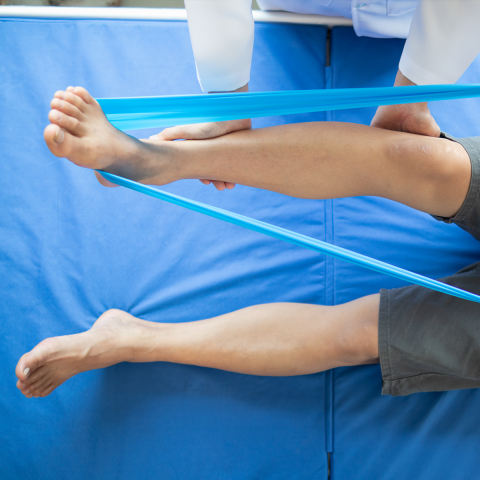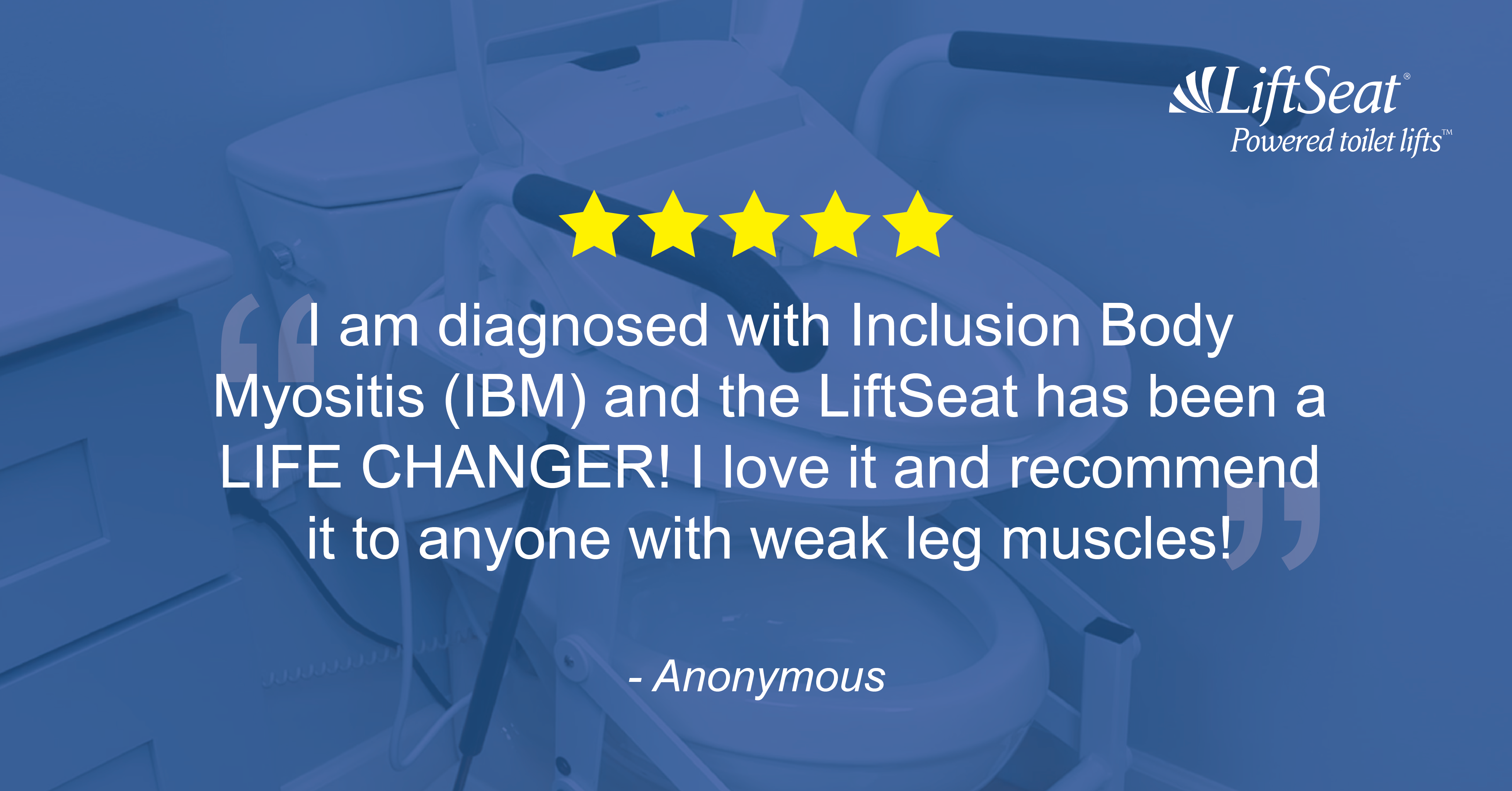Reducing Myositis Fall Risk - Key Strategies
04/10/2025
Falls are a common occurrence when living with myositis. Falls are one of the biggest reasons people visit a physician prior to being diagnosed with myositis, along with general weakness, difficulty climbing the stairs, and diminished arm and leg use.1
As myositis progresses, falls tend to increase in frequency, negatively impacting both individuals living with myositis and their caregivers. Identifying risk factors and implementing fall prevention strategies are important for maintaining mobility, preventing injuries, and supporting higher quality of life.
Incidence and Risk Factors
Myositis is characterized by a gradual and substantial weakening of the muscles. The quadriceps and lower leg muscles are some of the most affected muscle groups1, leading to the difficulty walking, climbing stairs, and tripping frequently reported by myositis patients.
As myositis progresses, muscle weakness intensifies. One research paper reported a mean strength loss of between 3-5% per year in individuals with sporadic inclusion body myositis. The report further noted that the “decline was most pronounced in the lower legs, which were also the weakest extremities.”2
Muscle weakness has been shown to be a risk factor for falls, particularly in older individuals.3 Other research has also specifically identified lower body weakness as a predictor of falls.4 It is not surprising then, that most individuals with myositis experience falls often, with one survey revealing that “falls were reported by 98% of respondents, with 60% falling frequently.”5
Physical and Psychological Impact
Falls have the potential to cause physical injury as well as psychological distress. A study looking at the incidence and impact of falls in patients with a range of neuromuscular disorders found that not only did these patients fall more frequently, but their falls often caused injury (both minor and major).6
In addition to the negative physical impact, the same study also found that a majority of these patients also developed a fear of falling and that many participated in fewer activities.6 Researchers looking at the impact of fear of falls in patients with inclusion body myositis (IBM) went on to further explore the impact of this fear on myositis patients, concluding “that this increased fear of falling negatively impacts a patient's quality of life and ability to participate in social activities”.7
Fall Prevention Strategies
To mitigate fall risk, there are several strategies that can be employed. Myositis patients should work with their healthcare provider to determine which strategies are right for them, but here are three well-known approaches.
Exercise
In recent years, exercise has been shown to have multiple positive impacts on myositis patients. Despite initial fears that exercise could be harmful, a growing body of research points to many benefits, from fall prevention to increased functional ability. One review, looking at a sampling of studies evaluating exercise across different types and levels of disease progression, concluded, “All studies report safety of exercise in all types and stages of myositis…”8
The authors of a more recent review note that “It is of particular importance to encourage IBM patients to engage in adapted regular physical activity to preserve independence and mitigate fall risk,” while also cautioning consideration of the impact exercise can have on fatigue.9 A third review pointed specifically to the benefits of resistance training for IBM, stating that this type of exercise “may help [in] preserving or even improving muscle strength in patients with IBM.”10
Another study based on a survey of over 900 individuals with inclusion body myositis reported a positive correlation between exercise and functional ability. This study found that both the participation in exercise and the amount of exercise impacted function, with respondents who engaged in more than five hours of exercise per week showing the greatest functional ability, compared to those who didn’t exercise and those who exercised less.1
Environmental Modifications
Improving home accessibility is an important step in fall prevention when living with any condition that limits mobility. Factors such as fatigue prevention and ease of movement should be considered to maximize accessibility.
Fatigue is a known contributor to falls, so layouts and configurations that maximize energy conservation should be employed. For instance, a single-level layout is easier to navigate than a split-level. For individuals who do not want to or are unable to move to a single-level living situation, assistive devices like a stair or wheelchair lift may be installed to circumvent the stairs.
Homes should also be configured to minimize tripping risk. Rugs should lay as flat as possible and have a non-skid backing. Floors and walkways should be clear of clutter, leaving plenty of room for movement. Doorways should also be widened for individuals using wheelchairs.
Assistive Devices
Fall risk can be further reduced with assistive devices, also commonly referred to as assistive technology or adaptive equipment.11 These devices include everything from larger items like wheelchairs to smaller tools like specially designed eating utensils.
When it comes to fall prevention, assistive devices designed to facilitate bathroom use are one of the most common - and most valued. In a survey of individuals living with myositis, toileting, personal care, and mobility devices were reported as the most used. Devices specifically related to toileting (including a bidet) were also rated as highly useful.12
Power toilet lifts are an excellent tool to reduce fall risk in the bathroom. Unlike grab bars and elevated toilet seats which often still require caregiver assistance to use, power toilet lifts allow many individuals to use the toilet completely independently.
LiftSeat Power Toilet Lifts support users throughout the full sit-to-stand motion, and offer a bidet option, for easy operation and hands-free cleaning. LiftSeat also offers the widest range of customization options, to accommodate individuals of varying sizes and mobility levels. Linda, a LiftSeat customer with IBM, gave her LiftSeat a 5-star rating, saying, “Excellent product for someone with inclusion body myositis.”

Exercise, environmental modifications, and assistive devices are all important strategies for reducing myositis-related falls. In addition to working with a healthcare provider, it may be good to speak with other individuals with myositis to discover different strategies and products they’ve found helpful. Organizations like The Myositis Association and Myositis Support and Understanding also offer abundant resources and recommendations for managing myositis.
References:
- Paltiel, A. D., Ingvarsson, E., Lee, D. K., Leff, R. L., Nowak, R. J., Petschke, K. D., Richards-Shubik, S., Zhou, A., Shubik, M., & O'Connor, K. C. (2015). Demographic and clinical features of inclusion body myositis in North America. Muscle & nerve, 52(4), 527–533. https://doi.org/10.1002/mus.24562
- Cox, F. M., Titulaer, M. J., Sont, J. K., Wintzen, A. R., Verschuuren, J. J., & Badrising, U. A. (2011). A 12-year follow-up in sporadic inclusion body myositis: an end stage with major disabilities. Brain: a journal of neurology, 134(Pt 11), 3167–3175. https://doi.org/10.1093/brain/awr217
- Horlings, C. G., van Engelen, B. G., Allum, J. H., & Bloem, B. R. (2008). A weak balance: the contribution of muscle weakness to postural instability and falls. Nature clinical practice. Neurology, 4(9), 504–515. https://doi.org/10.1038/ncpneuro0886
- Takada, H., Yamashita, K., Osawa, L., Komiyama, Y., Muraoka, M., Suzuki, Y., Sato, M., Kobayashi, S., Yoshida, T., Takano, S., Maekawa, S., & Enomoto, N. (2024). Assessment of lower limb muscle strength can predict fall risk in patients with chronic liver disease. Scientific reports, 14(1), 64. https://doi.org/10.1038/s41598-023-50574-7
- Hiscock, A., Dewar, L., Parton, M., Machado, P., Hanna, M., & Ramdharry, G. (2014). Frequency and circumstances of falls in people with inclusion body myositis: a questionnaire survey to explore falls management and physiotherapy provision. Physiotherapy, 100(1), 61–65. https://doi.org/10.1016/j.physio.2013.06.002
- Pieterse, A. J., Luttikhold, T. B., de Laat, K., Bloem, B. R., van Engelen, B. G., & Munneke, M. (2006). Falls in patients with neuromuscular disorders. Journal of the neurological sciences, 251(1-2), 87–90. https://doi.org/10.1016/j.jns.2006.09.008
- Hunn, S. & Weihl, Conrad. (2024). 212P Identifying biomarkers for prediction of fall-risk in patients with inclusion body myositis (IBM). Neuromuscular Disorders. 43. 104441.54. https://doi.org/10.1016/j.nmd.2024.07.063
- Alexanderson H. (2018). Exercise in Myositis. Current treatment options in rheumatology, 4(4), 289–298. https://doi.org/10.1007/s40674-018-0113-3
- Varone, N., Hinojosa, J., Nandakumar, D., Modi, N., Bhashyam, A. R., & Bhai, S. F. (2024). Exercise recommendations for patients with myositis: a narrative review of safety and efficacy. Clinical and experimental rheumatology, 42(2), 436–444. https://doi.org/10.55563/clinexprheumatol/m8fbs1
- Naddaf E. (2022). Inclusion body myositis: Update on the diagnostic and therapeutic landscape. Frontiers in neurology, 13, 1020113. https://doi.org/10.3389/fneur.2022.1020113
- Davalbhakta, Samira & Oswal, Akshay & Phatak, Sanat. (2020). Assistive devices: Regaining mobility in myositis. Indian Journal of Rheumatology. 15. https://doi.org/10.4103/injr.injr_90_20
- Cusso, M., Cooper, I., Beer, K., Naseri, C., Garbellini, S., Doverty, A., Corcoran, G., & Needham, M. (2024). Consumer-driven evaluation of assistive technology usage and perceived value in people with myositis in Australia. Australian occupational therapy journal, 71(5), 686–698. https://doi.org/10.1111/1440-1630.12954
This content is not intended to be a substitute for professional medical advice, diagnosis, or treatment. Always seek the advice of your physician or other qualified health provider with any questions you may have regarding a medical condition.